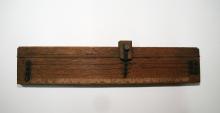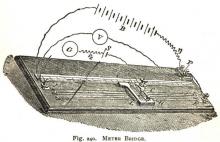A form of Wheatstone's bridge in which one lateral pair of arms is represented by a straight wire. The other pair comprise a known resistance, and the resistance to be determined. The galvanometer is connected on one side between the known and unknown resistance. On the other side its connection is moved back and forth along the straight wire until the balance is secured and the galvanometer reads zero.
The relative lengths of wire intercepted between the two ends thereof and the movable galvanometer connection are proportional to the resistance of these parts and give the necessary data with the one known resistance for determining the unknown resistance.
In the original meter bridge the wire was one meter long, whence its name, and was stretched straight.
The contact is not a sliding one, but is adjusted by trial. The contact piece is slid along, but not touching the wire, and from time to time is pressed down against the wire. This prevents wear of the wire. The wire may be made of platinum or of platinum-iridium alloy. The latter is very hard and not easily worn out.
Sometimes, as shown in the cut, three parallel wires are stretched along the baseboard of the instrument, and arranged so that a single wire, two wires or three wires in series can be used for the proportional sides of the bridge, thus making it a two-meter or three-meter bridge as desired.
In the cut J K is the wire, traversed by the contact key. By moving the contact C back and forth in the slot it can be brought over any of the three divisions of the wire. H is the handle for depressing the key. S is a flat spring, carrying the contact piece and holding it up from the wires, except when pressed downwards. As shown in the cut, it is in use for calibrating a voltmeter V, by Poggendorff's method, G being the galvanometer and r1 and r2 being resistances.


